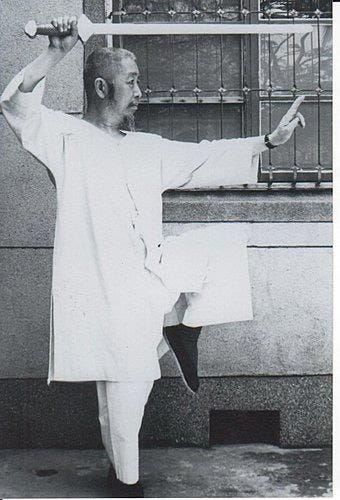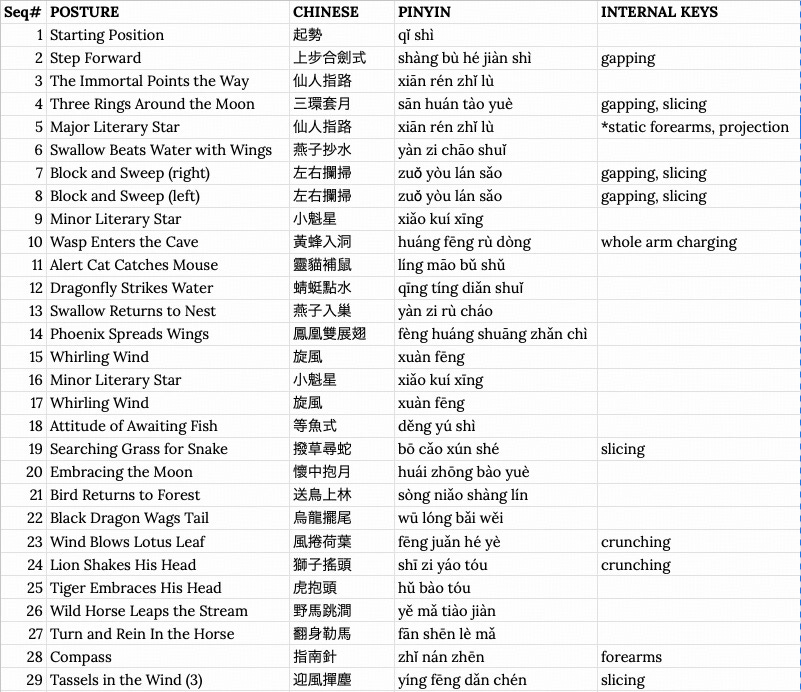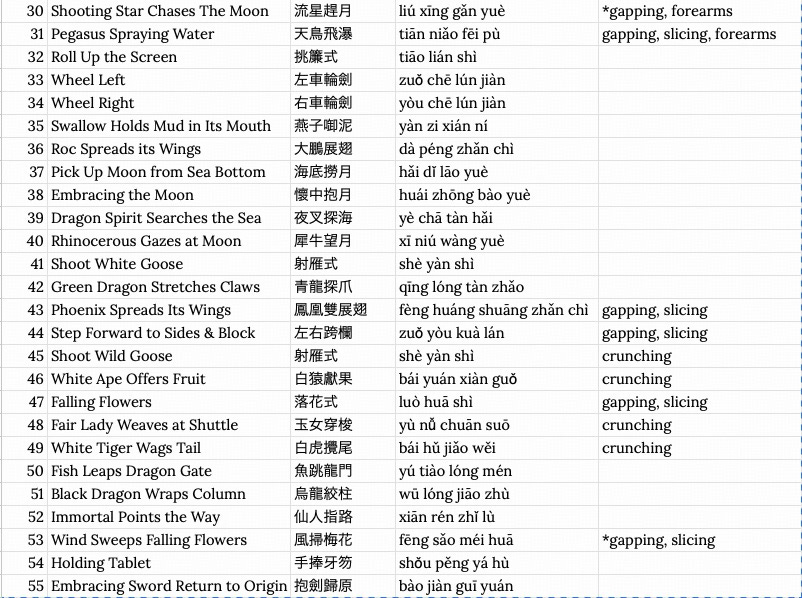Surge of Steel: Tai Chi Sword as Ultimate Neigong
"The sword - some keep for show but the wise for use"
- Welsh trad. proverb
This is the kind of content that should trigger y’all free subs to uplevel yourselves to paid. Not that I’m pushing for it. My content will always be fully available for free for anybody. But just out of respect for the depth of how I’m upleveling you guys here, you may want to revisit your sub status. I’ll be telling internal protocols that to my knowledge no author on this subject has ever put out publically.
People do sometimes learn Tai Chi sword. It’s a fun idea to get into it. People learn it, practice it regularly for a 3-week honeymoon period, then gradually drop off. It’s fun, but it’s also a little bit of a hassle in that you need the sword (cannot bring as carry-on, just saying), you need some space. Once the honeymoon’s over, people practice it less - from once a day to once a week to once a month and at that point it’s basically forgotten. It always feels good to practice, in a mildy calisthenic kind of way. But in this post we’re going in hard, as I’m doing a full reveal of why Tai Chi sword is the final boss of nei gong practices. The GOAT.
I held a sword event in June. I trust a good time was had by all. It was partly just for the fun of it, but the main purpose was actually more the 2nd of my ‘two birds one stone’ idea - I was hoping that by having the whole event filmed, a good tutorial long-form vid would kind of magically emerge. Unfortunately, as Ecclesiastes has noted, “time and chance happeneth” to us all. Meaning (a) I haven’t had time to process and edit all that footage; and (b) the production quality wasn’t good enough for a commercial product. Too bad, what a waste of time and effort THAT was.
But I did have some key points I wanted to convey to a wider audience. So I’ll run through those here and now, though I’m hereby totally spoiling any vestigial chance of spinning up a paid book or film which would reveal all this for pay. I’m leaving it all in the ring right here and now.
Tai Chi sword when it’s done at all, is usually pursued as a dance performance, or maybe a mild calisthenic. Sometimes for cultural appreciation. It’s done as a light physical exercise. That’s fine. It’s still a free country (kind of). But Tai Chi sword goes way beyond a heritage dance performance. If you can understand and incorporate what I’ll cover here, your resulting internal energy upgrade will knock your socks off.
I can’t rewrite all my other books here though, so you’ll need to be familiar with the whole ARC internal energy framework and experiential teaching that I cover in (to name a few) books such as Infusion, AXE, 5G Tai Chi, Tanden Revolution, and many others. Without that grounding this will be Greek to you.
Just a little more background before we get into the internal content. One thing is shed the physical orientation. While we do use the physical sequence and poses, the choreography, as a foundation, it’s way too easy to get caught up in how you look doing it, just the whole dance mentality. If people want to watch something pretty they’ll check out a Baryshnikov video, nobody wants to watch your sword play. You should have the attitude that you do it simply to gain the maximal training effect, not for any aesthetic reason. You should assume nobody wants to watch you play Tai Chi sword, any more than they want to watch you do pushups.
Physical relaxation, the absolute minimim tension, is essential at all times. Just as in the empty hand Tai Chi form. Relaxation is not the final purpose though - it’s only a prerequisite. An input not an output.
What you need to attend to are the energetic effects. Those are totally tangible. They aren’t a philosophy, concept, metaphor, image, poetry, delusion, superstition or anything else. They’re just as real as a brick dropped on your foot (though much more pleasant and interesting). Attend to those as you begin to experience them. It’s a built-in biofeedback mechanism that reinforces itself over time. This is the most important insight I can give you.
The sword should be gripped softly, with the main power control being just the middle finger of your right hand (though all fingers grip the handle softly, the controlling grip is just your middle finger). You may wonder what’s up with the weird two pointer fingers of your left hand. We could blow smoke and talk about deadly dim mak acu points poke of death here. Maybe that was a thing in ancient times. Now it has no functional significance at all, yet it’s extremely important. If we just let our hand “go”, if we let it collapse naturally into a blob shape, our mind would also be absent from our left hand as we do the form. Our mind must be minimally present in our right hand, just to keep the sword under control. But it seems that the left hand has no work and that it could just go AWOL, go limp. But that wouldn’t be optimal, because internal energy is attracted to and anchored by your mind. Having the “pointer fingers” requirement ensures a minimal symmetrical presence of mind in your left hand, just enough to serve as the terminus for energy circulation. Maintain that shape with the least tension possible for energy symmetry with the internal power that will be surging through your other arm and hand. You may not understand yet, but that pointer fingers requirement is a genius thing. Respect the idea for now, later you’ll feel the value deeply.
So, to get to it: you need to consciously incorporate the following internal practices within, inside of, your outer performance of the sword routine. I call them ‘Internal Keys’ in the charts below. They are actually all present, all the time, consistently in very move, start to finish. While learning their power and their effects however, there are some dynamics that bring them out more than others. So pay attention to the particular effects listed for the specific moves in the chart. Over time, once you’ve begun to really feel it, once you’re experienced, it will be trivial for your to expand the energetic phenomena across your practice of every move start to finish.
In a nutshell, these 3 principles of internal operation: Gapping, Slicing, Crunching.
Gapping: This one is the foundation of everything. This is where you cross the bridge from physicalized dance performance of Tai Chi sword into serious internal power training. Gapping is a consistent mostly-mental-slightly-physical orientation whereby you perceive, or slightly mentally emphasize a spatial gap between your sword arm and your torso. This is called out much more in some moves than others, but eventually will subtly apply to all. It’s as though you’re embracing an imaginary beach ball pressing apart your torso on one side and your sword arm on the other. If you wish to analogize this to the classical empty hand Tai Chi concept of peng, that’s ok. But the main thing is to actually feel the resulting huge and fully tangible energy amp. In the list below, you’ll see some designated key moves that are the easiest for beginners to intuit what I’m talking about here. Later, Gapping is a component of every move and transition in the form. Feel (mentally) as though you are drawing your torso slightly back away from your sword arm, in the moves singled out for Gapping in the list below.
Slicing: I almost hesitate to single this out because it seems on the surface so obvious. After all, the whole sequence is about slicing. No need to make a big thing out of it. But you have to put internal content into your slicing. The way to do that is to make sure every part from waist to wrist is participating in any slice move of the form. In a way it’s so simple, just sensitize yourself to begin to feel the internal power wave from your waist out to your slicing arm, to the sword wrist, sword hand - any beyond (into the weapon). But I know what you’re thinking even as you read that description. You’re mentally pegging this as either a generic concept (too high/abstract) or as a physical entrainment (too low/concrete). No, it’s that 3rd rail - the actual internal energy in motion. Begin each cross slice with your waist moving then your upper back, then your elbow picks up the power wave handoff (of focal energy not physical entrainment!), then your wrist as it flexes into the cut, then your gripping hand, with the internal power charge finally concentrating/culminating at your main gripping control on the handle which is your middle finger. Just feel the internal power wave (not the muscle or ligament entrainment) as you move. You won’t feel it at first but then you’ll start to.
Crunching: This is another torso thing, except rather than being mainly horizontal (the gap between your sword arm and your torso) this is about the vertical dimension. Think of your torso as a vertical accordion. Imagine it can lengthen upward, or compress into itself downward. This is a very important concept. If you want a dramatic illustration of the idea, look at my Xingyi ‘Dragon’ jump in the clip below. That’s an overdose in the Tai Chi context, but that’s the idea - except you do it basically with your mind alone, or 99% mind. Feel (initially in the moves so labeled in the chart below) that your torso is slightly vertically opening or extending upward, then in the next move, you should feel the slight compression. This starts as a physical awareness, then segues into the energetic sensation of crunching and er … uncrunching. Become sensitive to this and the sword form itself is engineered to take you onward from there.
So with the above in mind, study the chart below. Pay attention to the ‘Internal Keys’ column. Those entries mark which poses are essential for beginners to have their best shot at tasting what I’m talking about. Later you’ll find that all three key dimensions above (Gapping, Slicing, Crunching) are present in every sub-sequence and pose. Note: move #5, Major Literary Star will greatly reward prolonged static holding! It’s one of the more intensely productive zhan zhuang ‘post’ standing drills you can ever do. You can drop that in as a 4-minute stand as you do the form, just suspend for 4 minutes then carry on normally with the rest of the form.
To first get a taste of what I mean by Gapping, your best initial workbench is the early mini-sequence #4: Three Rings Around the Moon. Don’t short-change it, do the longer variant which include at least three reps of this super important pose.
For Slicing, your best bet for an initial taste is the three repeated down cuts of #19: Searching Grass for Snake.
For Crunching, by far your best chance of feeling it at first is the sub-sequence beginning with #21 (with torso extension/elongation) to #25. Just alternate from the #21 extension, you compress on #22, then extend on the next move, etc. That kind of alternation (from move to move) also happens in other subsequences, left as an exercise for the reader to discover.
The seven repeated moves of #47: ‘Falling Flowers’ is really where all the Principles come together, the culmination of the sword form in an incredibly power-packed mini-turbo overdrive.
I’m dealing myself out of a lot of revenue by laying it all out plain as day here, in a free blog post. Because I could’ve puffed this content into another whole book on The Final Edge of Nei Gong (I’d have added a bit more value with photos of the moves and more detailed directions.) But I’m putting it out here now because somebody had to do it.







